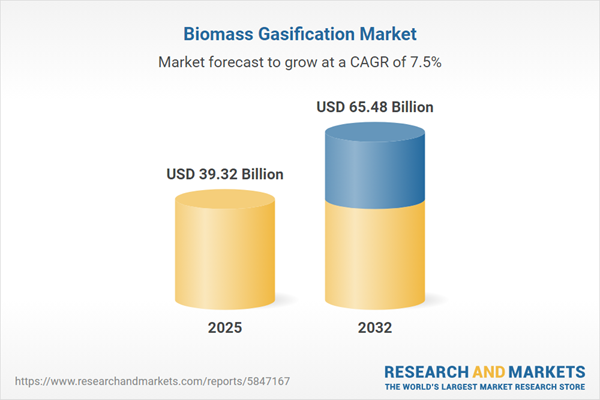Speak directly to the analyst to clarify any post sales queries you may have.
The biomass gasification market is evolving swiftly, shaped by innovative technologies, policy shifts, and expanding sustainability priorities. This report offers senior decision-makers a comprehensive analysis of the commercial, technological, and strategic dynamics underlying the global transition to cleaner, decentralized energy through biomass gasification.
Market Snapshot: Biomass Gasification Market Overview
The global biomass gasification market grew from USD 36.75 billion in 2024 to USD 39.32 billion in 2025. It is projected to expand further at a CAGR of 7.48%, reaching USD 65.48 billion by 2032. The sector’s growth is underpinned by decarbonization imperatives, increasing circular economy initiatives, and the urgency to diversify energy portfolios. As countries implement more ambitious renewable targets and carbon pricing, businesses recognize biomass gasification as a pivotal solution that transforms organic wastes into low-emission syngas for power, fuels, and chemicals. Regulatory incentives, evolving global trade policies, and technological breakthroughs are accelerating adoption across both established and emerging markets.
Scope & Segmentation
- Biomass Types: Agricultural residues, animal waste, forestry residues, municipal solid waste
- Gasifier Types: Entrained flow gasifiers, fixed bed gasifiers, fluidized bed gasifiers, plasma gasifiers
- Component Types: Control systems, gas engines, gasifier modules, power evacuation systems
- Applications: Chemical production, fuel production, power generation, thermal application, waste treatment
- End Users: Commercial sector, industrial sector, residential sector
- Regions Covered: Americas (North America: United States, Canada, Mexico; Latin America: Brazil, Argentina, Chile, Colombia, Peru); Europe, Middle East & Africa (Europe: United Kingdom, Germany, France, Russia, Italy, Spain, Netherlands, Sweden, Poland, Switzerland; Middle East: United Arab Emirates, Saudi Arabia, Qatar, Turkey, Israel; Africa: South Africa, Nigeria, Egypt, Kenya); Asia-Pacific (China, India, Japan, Australia, South Korea, Indonesia, Thailand, Malaysia, Singapore, Taiwan)
- Leading Companies: Ankur Scientific Energy Technologies, Babcock & Wilcox, Bellwether Recuperative Gasification, Beltran Technologies, Chanderpur Group, DP CleanTech, ENERKEM, Enersol Biopower, EQTEC PLC, Flex Technologies, Frontline BioEnergy, General Electric, HAFFNER ENERGY, Infinite Energy, KASAG Swiss AG, L'AIR LIQUIDE, Mitsubishi Heavy Industries, NTPC, Shell, Siemens, Sumitomo SHI FW, SunGas Renewables, SynCraft Engineering, Thyssenkrupp, Valmet Corporation, Yosemite Clean Energy
Key Takeaways for Senior Decision-Makers
- Biomass gasification delivers a lower-emission alternative to fossil energy sources by converting diverse organic feedstocks into syngas, supporting both renewable energy targets and waste valorization efforts.
- Innovations in reactor design, digital analytics, and feedstock pre-treatment significantly enhance process efficiency and operational reliability across varied deployment settings.
- Technology selection is closely tied to feedstock characteristics; for example, lignocellulosic materials favor certain gasifier types, while high-nitrogen streams require different approaches for optimum results.
- Cross-sector partnerships—particularly with agriculture, forestry, and waste management—enable scalable, resilient supply networks and enhance project viability within shifting regulatory landscapes.
- Commercial success is increasingly dependent on digital transformation, including real-time monitoring and predictive maintenance that drive higher yields and reduced downtimes.
- Financial stakeholders favor companies with measurable sustainability metrics, technology readiness, and alignment to corporate net-zero commitments.
Tariff Impact: 2025 U.S. Adjustments and Global Trade Patterns
The revised United States tariff schedules in 2025 significantly influenced international biomass supply chains. Import duties on primary feedstocks have prompted exporters—especially from North America and Europe—to reassess sourcing and logistics strategies. Project developers and technology providers now increasingly rely on local feedstock cultivation, dynamic partnership models, and resilient supply networks to stabilize costs amid trade barriers. Flexible licensing agreements and strategic alliances with agricultural and forestry entities are emerging as preferred solutions for risk mitigation in this evolving tariff environment.
Methodology & Data Sources
This analysis employs a mixed-methods approach, combining extensive secondary research with structured interviews and field surveys. Quantitative and qualitative findings were validated through data triangulation and proprietary case studies to ensure reliable, actionable insights tailored for all stakeholders across the biomass gasification value chain.
Why This Report Matters for Decision-Makers
- Enables executives to optimize feedstock supply chains, technology investments, and modular deployment strategies based on market-specific intelligence
- Supports proactive response to regulatory changes and trade barriers while enhancing operational sustainability and financial resilience
- Delivers actionable insights on partnership opportunities, digital transformation initiatives, and competitive differentiation within the global energy transition
Conclusion
Stakeholders who leverage emerging technologies, adaptive supply networks, and data-driven operations are best positioned to lead in the advancing biomass gasification market. Investing in collaboration and continuous improvement will drive sustainable value and unlock new growth opportunities as the industry matures.
Additional Product Information:
- Purchase of this report includes 1 year online access with quarterly updates.
- This report can be updated on request. Please contact our Customer Experience team using the Ask a Question widget on our website.
Table of Contents
3. Executive Summary
4. Market Overview
7. Cumulative Impact of Artificial Intelligence 2025
Companies Mentioned
The companies profiled in this Biomass Gasification market report include:- Ankur Scientific Energy Technologies Pvt. Ltd.
- Babcock & Wilcox Enterprises, Inc.
- Bellwether Recuperative Gasification Ltd.
- Beltran Technologies, Inc.
- Chanderpur Group
- DP CleanTech
- ENERKEM Inc.
- Enersol Biopower Private Limited
- EQTEC PLC
- Flex Technologies Limited
- Frontline BioEnergy, LLC.
- General Electric Company
- HAFFNER ENERGY
- Infinite Energy Pvt. Ltd.
- KASAG Swiss AG
- L’AIR LIQUIDE S.A.
- Mitsubishi Heavy Industries, Ltd.
- NTPC Limited
- Shell PLC
- Siemens AG
- Sumitomo SHI FW
- SunGas Renewables Inc.
- SynCraft Engineering GmbH
- Thyssenkrupp AG
- Valmet Corporation
- Yosemite Clean Energy
Table Information
| Report Attribute | Details |
|---|---|
| No. of Pages | 185 |
| Published | November 2025 |
| Forecast Period | 2025 - 2032 |
| Estimated Market Value ( USD | $ 39.32 Billion |
| Forecasted Market Value ( USD | $ 65.48 Billion |
| Compound Annual Growth Rate | 7.4% |
| Regions Covered | Global |
| No. of Companies Mentioned | 27 |









